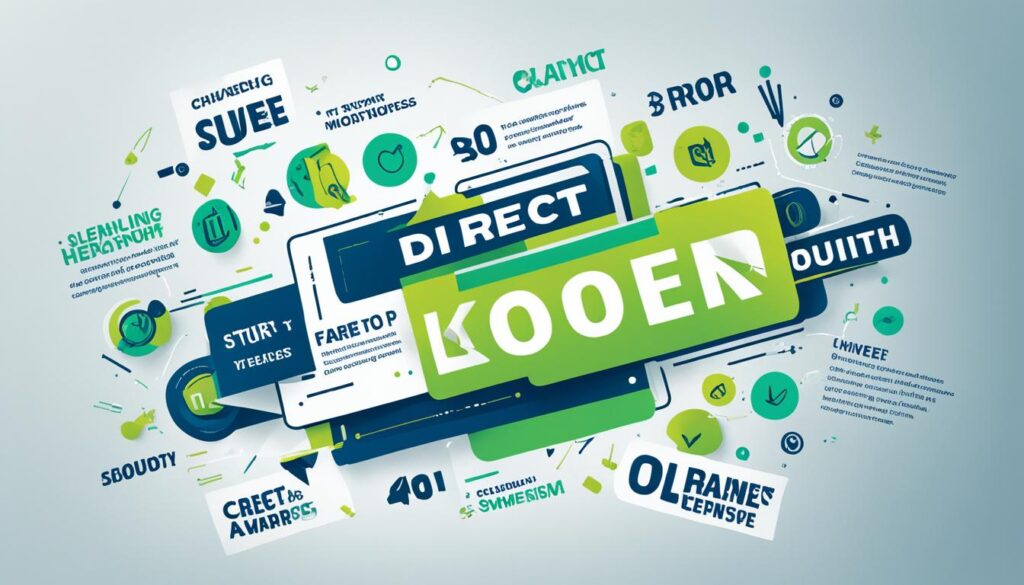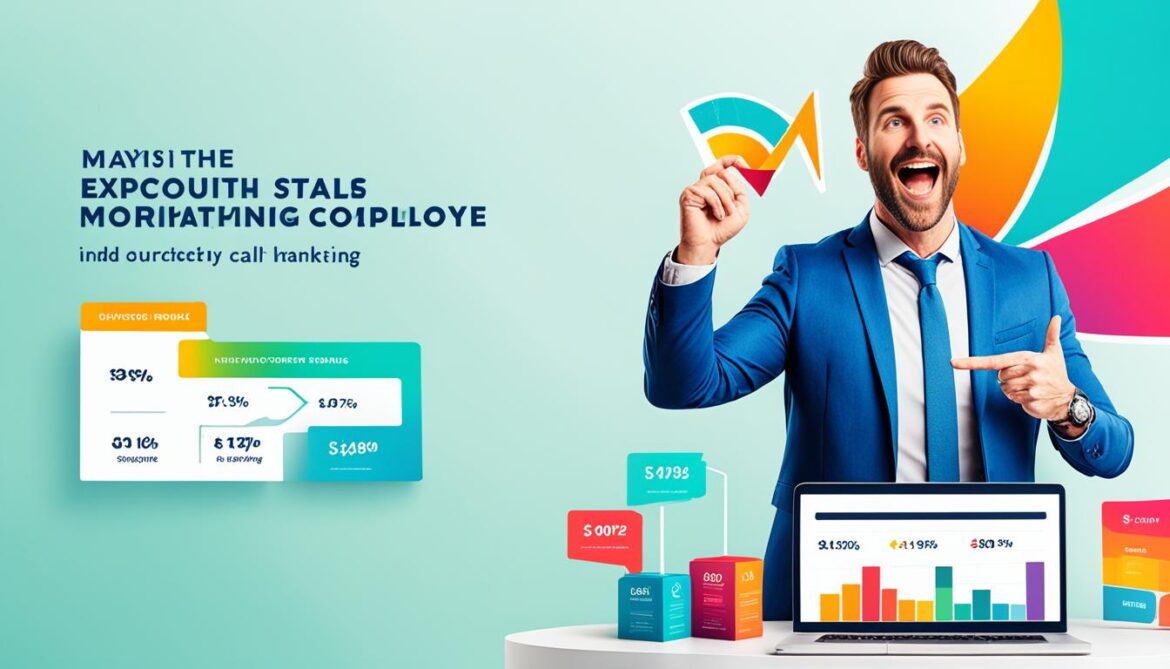Direct response marketing is a short-term approach that focuses on generating immediate responses and conversions from customers. It is different from traditional marketing methods that aim to build brand awareness over time. Direct response marketing allows businesses to measure the success of their campaigns and make data-driven decisions to optimize results.
This article will explore the benefits of direct response marketing, provide examples of effective strategies, and offer tips for building successful direct response campaigns.
Key Takeaways:
- Direct response marketing generates immediate responses and conversions.
- It allows businesses to measure the success of their campaigns.
- Direct response marketing focuses on targeted marketing and lead generation.
- Conversion optimization and customer engagement are key aspects of direct response marketing.
- Response rates can be tracked and optimized for better results.
What is Direct Response Marketing?
Direct response marketing is a marketing strategy that focuses on generating immediate responses and conversions from customers. Unlike traditional marketing that aims to build brand awareness, direct response marketing seeks to turn leads into customers and increase sales. It is targeted towards specific actions such as purchasing, subscribing, or requesting more information. This approach allows businesses to see immediate ROI and measure the success of their campaigns.
To better understand direct response marketing, let’s take a closer look at how it differs from traditional marketing. While traditional marketing focuses on creating awareness and building brand reputation, direct response marketing is all about generating tangible results. It cuts through the noise and aims to elicit an immediate response from its audience, whether it’s making a purchase, filling out a form, or contacting the business.
Direct response marketing is highly measurable and allows businesses to track the effectiveness of their campaigns. By analyzing conversion rates, lead generation, and sales data, businesses can make data-driven decisions to optimize their marketing efforts and maximize their ROI.
This approach is especially beneficial for businesses that operate in competitive industries, where standing out and capturing the attention of potential customers is crucial. Instead of relying solely on brand recognition and long-term visibility, direct response marketing focuses on delivering targeted messages to specific segments of the audience, driving them towards a desired action.
Key Components of Direct Response Marketing
Effective direct response marketing campaigns require careful planning and execution. Here are some key components:
- Compelling Offer: A strong and persuasive offer is essential to capture the audience’s attention and prompt them to take action. This could be a limited-time discount, a free trial, or an exclusive bonus.
- Clear Call to Action (CTA): Direct response marketing depends on clear and concise CTAs that guide the audience towards the desired action. Whether it’s clicking a button, making a phone call, or subscribing to a newsletter, the CTA should be prominent and easy to follow.
- Targeted Audience: Direct response marketing relies on understanding the target audience’s needs, preferences, and pain points. By segmenting the audience and tailoring the message to specific groups, businesses can increase the relevancy and effectiveness of their campaigns.
- Compelling Copywriting: Persuasive and compelling copy is vital for direct response marketing. The copy should highlight the benefits of the product or service, address the audience’s pain points, and create a sense of urgency.
By incorporating these components into their campaigns, businesses can effectively engage their audience, generate conversions, and drive sales.
| Benefits of Direct Response Marketing | Examples |
|---|---|
| 1. Measurable Results: Direct response marketing allows businesses to track campaigns and measure their success. This provides valuable insights into the ROI and enables optimization for better results. | |
| 2. Immediate Conversions: Unlike traditional marketing that focuses on long-term brand building, direct response marketing aims to drive immediate conversions, leading to faster revenue generation. | |
| 3. Targeted Audience: With direct response marketing, businesses can target specific audience segments based on demographics, interests, and behaviors. This enables more personalized and relevant messaging. | |
| 4. Higher Customer Engagement: By offering compelling incentives and tailored messages, direct response marketing fosters deeper engagement with the audience, increasing the likelihood of repeat purchases and customer loyalty. |
In the next section, we will explore some real-world examples of direct response marketing campaigns and how they have successfully driven conversions and sales for businesses.
Examples of Direct Response Marketing
Direct response marketing can take various forms, including emails, QR codes, chatbots, referrals, giveaways, and contests. These strategies are designed to engage customers and drive immediate responses and conversions. Let’s explore some real-world examples of direct response marketing:
Emails
Email marketing is a powerful tool for direct response campaigns. By crafting compelling subject lines, personalized content, and enticing offers, businesses can encourage recipients to take action. For example, a clothing retailer might send an email with a limited-time discount code, prompting customers to make a purchase.
QR Codes
QR codes provide a seamless way to bridge offline and online experiences. By placing QR codes on print materials or in-store displays, businesses can redirect customers to targeted landing pages or offer exclusive discounts. A restaurant might include a QR code on a menu, allowing customers to easily access their online ordering system.
Chatbots
Chatbots are AI-powered virtual assistants that can engage users in real-time conversations. They can provide instant support, answer questions, and guide customers through the sales process. For example, an e-commerce website might employ a chatbot to assist customers with product recommendations and purchasing decisions.
Referrals
Referrals are a powerful form of direct response marketing that leverages the relationships and networks of existing customers. By incentivizing customers to refer their friends and family, businesses can expand their customer base while rewarding loyal customers. For instance, a fitness studio might offer a free class to both the referrer and the referred friend.
Giveaways and Contests
Giveaways and contests create a sense of excitement and engage customers in a fun and interactive way. By offering the chance to win a prize, businesses can encourage participation and generate leads. An electronics retailer might run a social media contest where participants need to share a post and tag a friend for a chance to win the latest gadget.
These examples demonstrate the versatility of direct response marketing and highlight the various ways businesses can capture the attention and interest of their target audience. By strategically implementing these tactics, businesses can generate immediate responses, increase conversions, and build a loyal customer base.
Components of Direct Response Campaigns
Direct response campaigns consist of several components that contribute to their success. These include personalization, segmentation, compelling sales copy, clear calls to action (CTAs), and the benefits of the offer.
Personalization
Personalization involves understanding the audience’s pain points and goals to create customized offers. By tailoring the messaging and content to resonate with individual customers, businesses can enhance customer experience and increase engagement. Personalization can be achieved through data analysis, customer segmentation, and targeted marketing campaigns.
Segmentation
Segmentation plays a crucial role in direct response campaigns. By dividing the target audience into specific segments based on interests, behaviors, and demographics, businesses can deliver targeted messages and offers that are more likely to resonate with each segment. This approach allows for a more efficient use of marketing resources and increases the likelihood of conversion.
Compelling Sales Copy
Compelling sales copy is essential in capturing the attention and interest of the audience. It should be persuasive, concise, and highlight the unique selling points of the product or service. By crafting compelling sales copy, businesses can create a sense of urgency and motivate customers to take immediate action.
Clear Calls to Action (CTAs)
Clear calls to action (CTAs) prompt the audience to take the desired action, whether it’s making a purchase, subscribing, or requesting more information. CTAs should be prominently displayed and use persuasive language to encourage the audience to engage with the offer. A well-designed and strategically placed CTA can significantly impact the conversion rate of a direct response campaign.
Benefits of the Offer
Direct response campaigns should emphasize the benefits that customers will gain by taking the desired action. Whether it’s cost savings, convenience, or improved quality of life, clearly communicating the benefits helps to enhance the perceived value of the offer. Highlighting the benefits can be done through engaging visuals, persuasive copy, and customer testimonials.
By integrating these components into direct response campaigns, businesses can create compelling and targeted marketing efforts that drive conversions and maximize the benefits for both the business and the customer.
| Component | Description |
|---|---|
| Personalization | Understanding the audience’s pain points and goals to create customized offers based on individual preferences. |
| Segmentation | Dividing the target audience into specific segments based on interests, behaviors, and demographics for targeted messaging. |
| Compelling Sales Copy | Persuasive and concise messaging that highlights the unique selling points of the product or service. |
| Clear Calls to Action (CTAs) | Prominently displayed prompts that encourage the audience to take the desired action. |
| Benefits of the Offer | Emphasizing the advantages and value that customers will gain by engaging with the offer. |

Benefits of Direct Response Marketing
Direct response marketing offers several benefits for businesses. By adopting this approach, companies can maximize their sales and engagement while building strong customer relationships. Let’s explore the key advantages direct response marketing brings to the table.
1. Enhanced Communication with Prospects
Direct response marketing creates a direct line of communication with prospects. By targeting specific actions such as purchasing or requesting more information, businesses can engage their audience in personalized interactions. This tailored communication fosters a deeper understanding of customer needs and preferences, leading to higher conversion rates and customer satisfaction.
2. Measurable and Trackable Results
One of the main benefits of direct response marketing is its focus on producing measurable and trackable results. Through the use of analytics and tracking tools, businesses can accurately measure the success of their campaigns. This data-driven approach allows for optimization and informed decision-making, leading to continuous improvement and better campaign performance.
3. Strengthened Customer Relationship
Direct response marketing enables businesses to provide targeted offers and relevant content to their customers. By tailoring their messages to the specific needs and interests of their audience, companies can establish a deeper connection and strengthen the customer relationship. This personalized approach fosters trust and loyalty, leading to increased customer retention and advocacy.
4. High Return on Investment (ROI)
Direct response marketing campaigns are designed to drive conversions and generate immediate results. With their focus on compelling calls-to-action (CTAs) and benefits, these campaigns have a higher likelihood of generating sales and delivering a significant return on investment. The ability to track and measure campaign performance also allows businesses to optimize their marketing spend, ensuring that resources are allocated where they yield the highest ROI.
5. Upsells and Repeat Purchases
Direct response marketing presents opportunities for upselling and encouraging repeat purchases from existing customers. By leveraging personalized offers and targeted messaging, businesses can entice customers to upgrade or purchase additional products and services. This approach not only boosts revenue but also strengthens the overall customer lifetime value.
In conclusion, direct response marketing offers numerous benefits to businesses. From improved communication with prospects to measurable results and a strengthened customer relationship, this approach provides a strategic advantage in today’s competitive landscape. With a high return on investment and the potential for upsells, direct response marketing proves to be an essential component of a successful marketing strategy.
5 Tips for Building Direct Response Campaigns
Building successful direct response campaigns requires careful planning and execution. Here are five tips to maximize the effectiveness of your campaigns:
-
1. Craft an Effective Call to Action
An effective call to action (CTA) is crucial for driving easy response and conversions. Make sure your CTA is clear, compelling, and easy to follow. Use action words and urgency to prompt immediate action from your audience. For example:
Subpar CTA Effective CTA Create an Account Get Instant Access Now! Contact Us Book Your Free Consultation Today! -
2. Leverage Referrals and Giveaways
Referrals are a powerful way to expand your customer base and increase trust. Encourage your satisfied customers to refer their friends and offer incentives, such as discounts or exclusive access, for successful referrals. Additionally, giveaways create excitement and generate buzz around your brand. Consider running contests or promotions where participants can win valuable prizes. This not only increases engagement but also attracts potential customers.
-
3. Utilize Facebook Chatbots
Facebook chatbots are valuable tools for building direct response campaigns. These automated chat systems provide instant responses and personalized interactions with your audience. Use chatbots to engage with customers, answer inquiries, and guide them through the conversion process. By leveraging this technology, you can streamline customer interactions and enhance the overall user experience.
-
4. Create Compelling Content
Compelling content plays a crucial role in direct response campaigns. Your content should be informative, persuasive, and relevant to your audience’s needs. Use storytelling techniques, captivating visuals, and persuasive language to create an emotional connection with your audience. By presenting the benefits and value of your offer in a compelling way, you can increase the likelihood of a positive response.
-
5. Test and Optimize
Testing and optimization are integral to building effective direct response campaigns. Continuously monitor and analyze the performance of your campaigns to identify areas for improvement. Test different variations of your CTAs, audience segments, and content to uncover what resonates best with your target audience. By making data-driven adjustments, you can optimize your campaigns for maximum response rates and conversions.
Direct Response Marketing Channels
Direct response marketing campaigns can leverage a variety of channels to effectively reach and engage target audiences. From digital ads to traditional direct mail, businesses have numerous options to implement their direct response strategies. Here are some key channels to consider:
Digital Ads
In the digital age, digital ads play a crucial role in direct response marketing. Platforms such as Facebook and Instagram offer targeted advertising options that allow businesses to reach specific demographics, interests, and behaviors. These visually engaging ads capture audience attention and drive immediate responses.
Email Campaigns
Email campaigns remain a powerful channel for direct response marketing. With the ability to personalize content and deliver offers directly to inboxes, businesses can establish a direct line of communication with their target audience. Timely and relevant email campaigns can drive conversions, generate leads, and nurture customer relationships.
Pay-Per-Click (PPC) and Paid Social Ads
PPC and paid social ads are highly effective channels for capturing high-intent traffic and driving leads or sales. Pay-per-click campaigns ensure that businesses only pay when users click on their ads, making it a cost-effective option. Paid social ads, such as those on Facebook or LinkedIn, enable businesses to target specific audiences based on their demographics, interests, and behaviors.
Television and Connected TV Ads
Television has long been a prominent advertising medium, and with the rise of connected TV, this channel offers even more opportunities for direct response marketing. Television and connected TV ads blend traditional formats with interactive capabilities, allowing businesses to reach a wide audience while also targeting specific demographics or geographic areas.
SMS
SMS (short messaging service) campaigns provide businesses with a direct and immediate way to communicate with their audience. SMS messages can be used to send personalized offers, promotions, or updates, enabling businesses to drive immediate responses and engagement.
Direct Mail
Although often associated with traditional marketing, direct mail can still be a highly effective channel for direct response campaigns. Well-designed direct mail pieces can grab the recipient’s attention and deliver personalized messages or offers directly to their mailbox. This physical form of marketing can make a lasting impression and drive immediate action.
By leveraging these direct response marketing channels in their campaigns, businesses can reach their target audience through various touchpoints and maximize the effectiveness of their marketing efforts.
Conclusion
Direct response marketing provides businesses with a powerful tool to generate immediate responses and conversions from customers. By implementing personalized campaigns, effective calls to action (CTAs), and leveraging various marketing channels, businesses can maximize their sales and engagement. The benefits of direct response marketing are numerous. It allows for better communication with prospects, leading to deeper customer relationships and increased customer loyalty. Measurable results enable businesses to make data-driven decisions and optimize their campaigns for better performance.
Direct response marketing also offers a high return on investment (ROI) as campaigns are designed to drive conversions and generate revenue. It opens up opportunities for upsells and repeat purchases from existing customers, further boosting revenue and profitability. As technology continues to advance, future trends in direct response marketing are expected to include more advanced targeting capabilities, interactive experiences, and personalized automation. By staying ahead of the competition and consistently refining their direct response strategies, businesses can achieve remarkable growth and success in the ever-evolving marketing landscape.
In conclusion, direct response marketing is a valuable approach that allows businesses to generate immediate results, nurture customer relationships, and achieve their sales goals. With its proven benefits and promising future trends, businesses should embrace and optimize their direct response marketing efforts for maximum success.
FAQ
What is direct response marketing?
Direct response marketing is a strategy that focuses on generating immediate responses and conversions from customers, instead of building long-term brand awareness.
What are some examples of direct response marketing?
Examples of direct response marketing include emails, QR codes, chatbots, referrals, giveaways, and contests.
What are the components of a direct response campaign?
The components of a direct response campaign include personalization, segmentation, compelling sales copy, clear calls to action (CTAs), and highlighting the benefits of the offer.
What are the benefits of direct response marketing?
Direct response marketing offers benefits such as better communication with prospects, measurable results, stronger customer relationships, high return on investment (ROI), and opportunities for upsells.
What are some tips for building direct response campaigns?
Tips for building direct response campaigns include making it easy for customers to respond, creating effective CTAs, utilizing referrals and giveaways, and leveraging Facebook chatbots.
What channels can be used for direct response marketing?
Direct response marketing can be implemented through various channels, including digital ads, email campaigns, PPC, paid social ads, TV and connected TV ads, SMS, and direct mail.







